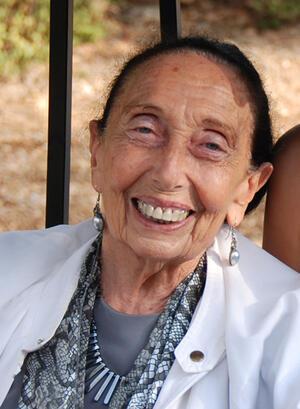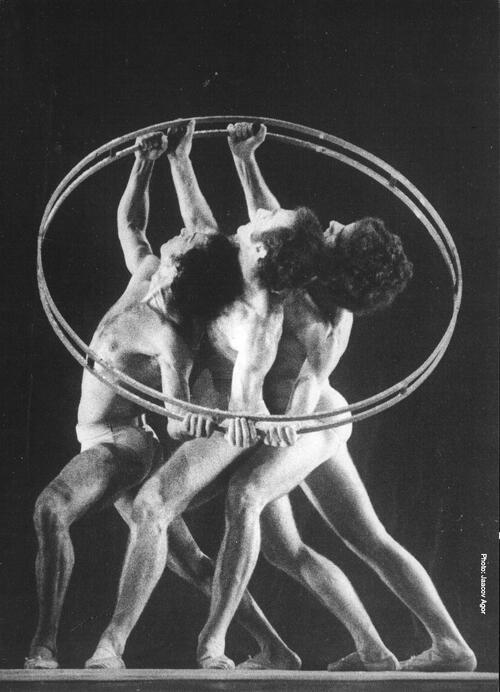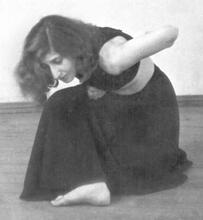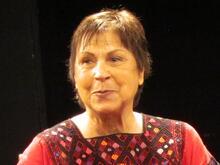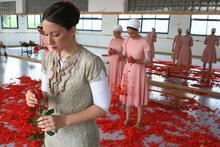Yehudit Arnon
After surviving the Holocaust and immigrating to Palestine, Yehudit Arnon played an influential role in shaping modern dance in Israel and founded the famous Kibbutz Contemporary Dance Company. Arnon suffered many death-defying experiences in concentration camps, including the freezing cold, harsh camps, a death march, and a firing squad. In 1948 Arnon and her husband helped to smuggle more than 100 orphaned children to Palestine and settled in Kibbutz Ga'aton. By 1962, Arnon had created a modern dance company, winning first prize at the Israel Festival for Young Artists. She became director of the Kibbutz Dance Company in 1970. Arnon received the 1997 Distinguished Artist Award of the International Society for the Performing Arts, and in 1998 she received the Israel Prize.
Early Life and Family
Yehudit (Judith) Schischa-Halevy, born on October 15, 1926, in Komárno, Czechoslovakia (87 km ESE of Bratislava), was the youngest of the three children of Ludwig Schischa-Halevy (1881–1944) and Elisabeth (Betty) Hoffmann (1891–1944). Yehudit’s father’s surname Schischa (Hebrew for six) indicates the family’s Sephardic roots. Even after his marriage to Elisabeth (Betty) Hoffmann, who came from Sárvár, Hungary, Schischa regularly traveled to Vienna, where he maintained a shoe store. Elizabeth had a beautiful singing voice, but sang only at home as befitted the wife in an arranged, observant marriage. Yehudit related: “My father did beautiful handiwork, and as my mother was often ill, my father would draw her pictures, even on the ceiling, as she lay in bed.” Yehudit’s brother Feri, also known as Fred Sheldon (1923–1974) and her sister Zsuzsi, also known as (Suzan) Price (1920–1977), learned music, but she herself was not permitted by the rabbis to dance. Nevertheless, because she suffered from scoliosis, she was sent to a physical therapist, who taught her various exercises. Her gymnastics teacher in primary school was so impressed with her talent that she permitted her to conduct the class. However, her greatest love was the Zionist youth group Ha-Shomer ha-Za’ir, where she learned about Zionism and culture. Even though the family was religious, her parents allowed her to participate in the movement’s activities. Her sister left for Palestine in 1939 and during World War II served with the Jewish Brigade in Europe until 1946. Her brother was conscripted to the Hungarian Labor Service system (Munkaszolgalat) from 1943 to 1945. After World War II they both emigrated to Australia.
Holocaust
Schischa-Halevy and her parents were sent to Auschwitz on June 11, 1944, after spending three days at the assembly point in the Komárno Ghetto. She faced many selections during the war years but what she recalls relates specifically to Mengele: when she arrived at Auschwitz, she told him in German that she wished to remain with her sickly mother. He politely beguiled her with assurances though he selected her mother immediately for the gas chamber and sent Yehudit to the Birkenau camp with the other young people. In a Yad Vashem video interview, she said: “Somehow we managed to live and even entertain each other. I was asked to show movement—sometimes acrobatics and other times movement jokes that I made up—and I realized I did something good.”
Just before Christmas Eve of 1944, the Kapo (an inmate appointed by the Germans to head a work gang of other prisoners) told Yehudit that the SS wanted her to dance at their Christmas party in Auschwitz. When she refused she was forced as punishment to stand barefoot in the snow. There and then she decided that if she survived, she would dedicate herself to dance.
Yehudit suffered through the freezing cold, labor camps, a death march, and another death-defying experience at a Moravian camp in May 1945. She stood in front of a firing squad, heard the guns cock, and then, “Suddenly we heard screams and the Germans started escaping. The Red Army was coming. This critical moment between death and freedom caused total confusion” (February 2002). Escaping, she eventually reached Budapest, where she taught youngsters and choreographed pageants for Ha-Shomer ha-Za’ir. In the organization, she met other artists, including Irena Dückstein, a Hungarian dancer who had taught at the Budapest Academy of Physical Education and was Dean of the Faculty of Movement Arts (1946). Before the war, Irena had assisted the German choreographer Kurt Jooss. Although Dückstein wanted Yehudit to be her assistant, she refused the offer because she had already met Yedidya Ahronfeld (b. 1922, Budapest) who wanted to go to Palestine. They were married on June 16, 1946. He changed their family name to Arnon. Before the couple left on their complicated journey to Palestine, Dückstein gave Yehudit a three-day crash course in dance theory and modern technique.
Post-War Years and Immigration to Palestine
Working with more than one hundred orphaned children aged six to sixteen who had no common language, she taught dance and mathematics—both subjects requiring no language. To get the orphans safely to Palestine, the Arnons smuggled them over borders, walking through forests, reaching Innsbruck and other stops, including eight months in a convent near Turin and the DP camp near Avigliana in their clandestine journey.
In 1948 the Arnons reached Palestine by ship from Venice with the children. The couple joined A voluntary collective community, mainly agricultural, in which there is no private wealth and which is responsible for all the needs of its members and their families.Kibbutz Ga’aton. Besides working in the laundry Arnon managed to travel to Haifa to study with the outstanding Israeli dancers Gertrud Kraus and Yardena Cohen. A voluntary collective community, mainly agricultural, in which there is no private wealth and which is responsible for all the needs of its members and their families.Kibbutzim favored folk dance and egalitarian participation regardless of talent, but through her unique persistence, she convinced her kibbutz of the importance of modern dance. Arnon taught dance and choreographed for kibbutz functions, gaining more and more followers while also raising three daughters, Ruthie (b. 1949), Ronnith (b. 1954) and Efrath (b. 1961).
Modern Dance Career
By 1962 Arnon had created a modern dance company, winning first prize at the Israel Festival for Young Artists. The kibbutz built her a proper dance studio in 1965 and she opened a regional dance center at Ga’aton for youngsters from kibbutzim throughout the region. She became director of the Kibbutz Dance Company in 1970 and during her twenty–five–year tenure persuaded choreographers and teachers from Israel and abroad to come to the studio in the far north of the country. The guests, who taught both for the school and for the company, included Israeli professionals Hedda Oren, Oshra Elkayam, Ya’acov Sharir, Flora Cushman, and Rami Be’er. An American especially important to the company was Gene Hill-Sagan (USA, 1936–1991). European choreographers have included Jiri Kylian, Matts Ek and Suzanne Linke. Kylian, an important Dutch choreographer, wrote “We met many years ago in my office in the old studios of the Nederlands Dans Theater. I will always remember your slight figure and unassuming strength of conviction—to make a statement as a survivor who does not only want to live on but wishes to hand something of great moment to the present generation, a message of dance which represents freedom” (1996: 126).
Under Arnon’s direction, the Kibbutz Contemporary Dance Company toured throughout Israel, the United States, Europe, and the Far East. In 1996 she became the director emerita of the Kibbutz Dance Company. Yehudit’s protégé and student from the time he was a child on Kibbutz Ga’aton was Rami Be’er. He danced with the company and in 1996 succeeded her as its director. Arnon continued to teach at the now-famous Kibbutz Ga’aton Dance Center, also taking time for her family, which includes a granddaughter and five grandsons.
Legacy
Noteworthy prizes Arnon received include the 1997 Distinguished Artist Award of the International Society for the Performing Arts “in recognition of her extraordinary contributions of creative talent and inspiration to the world of dance.” In 1998 she received the Israel Prize, the country’s highest award, for her lifelong achievements in education and the performing arts.
Arnon passed away on August 17, 2016, at the age of 87.
For Further Viewing:
Will You Dance For Me (2011) by Ori Gersht
Arnon, Yehudit. Interview with author. Kibbutz Ga’aton, Israel, February 5, 2002.
Arnon, Yehudit, curriculum vitae.
Bashari, Yael. “Yehudit Arnon.” University paper, 1998.
Eshel, Ruth. “Before the Beginning: The Prehistory of the Kibbutz Dance Movement.” Israel Dance 9 (1996): 128–137.
Kave, Avshalom. Ahuzat Mahol (Overseer of the Dance Estate, in a State of Rapture over Dance: Yehudit Arnon and the Kibbutz Dance Company). Tel Aviv: 2003.
Manor, Giora. “Twenty-Five Years of Creativity: The Kibbutz (Contemporary) Dance Company.” Israel Dance 9 (1996): 123–127.
Mateh Asher School of Performing Arts brochure, published at Kibbutz Ga’aton, Israel.
Weiss, Smadar. “Remembrance: Image and Word, ‘Aide Memoire’ by Rami Be’er.” Mahol Akhshav, (Dance Today, The Dance Magazine of Israel), May 2002: 36–38.
Yad Vashem, master index S-117, microfiche information on Arnon’s concentration camp location and dates.

